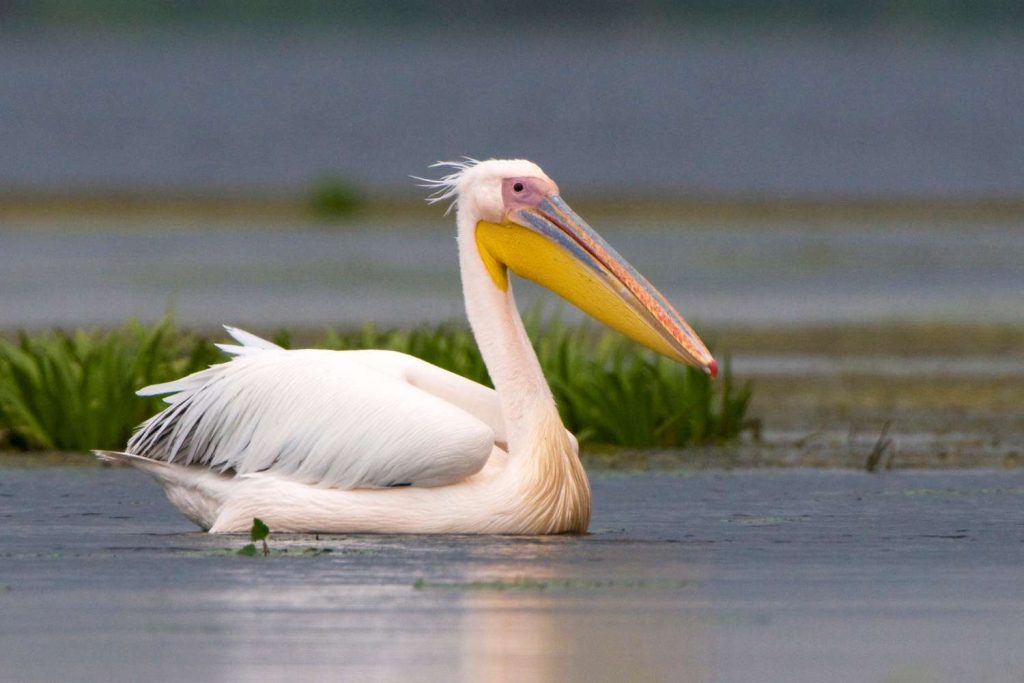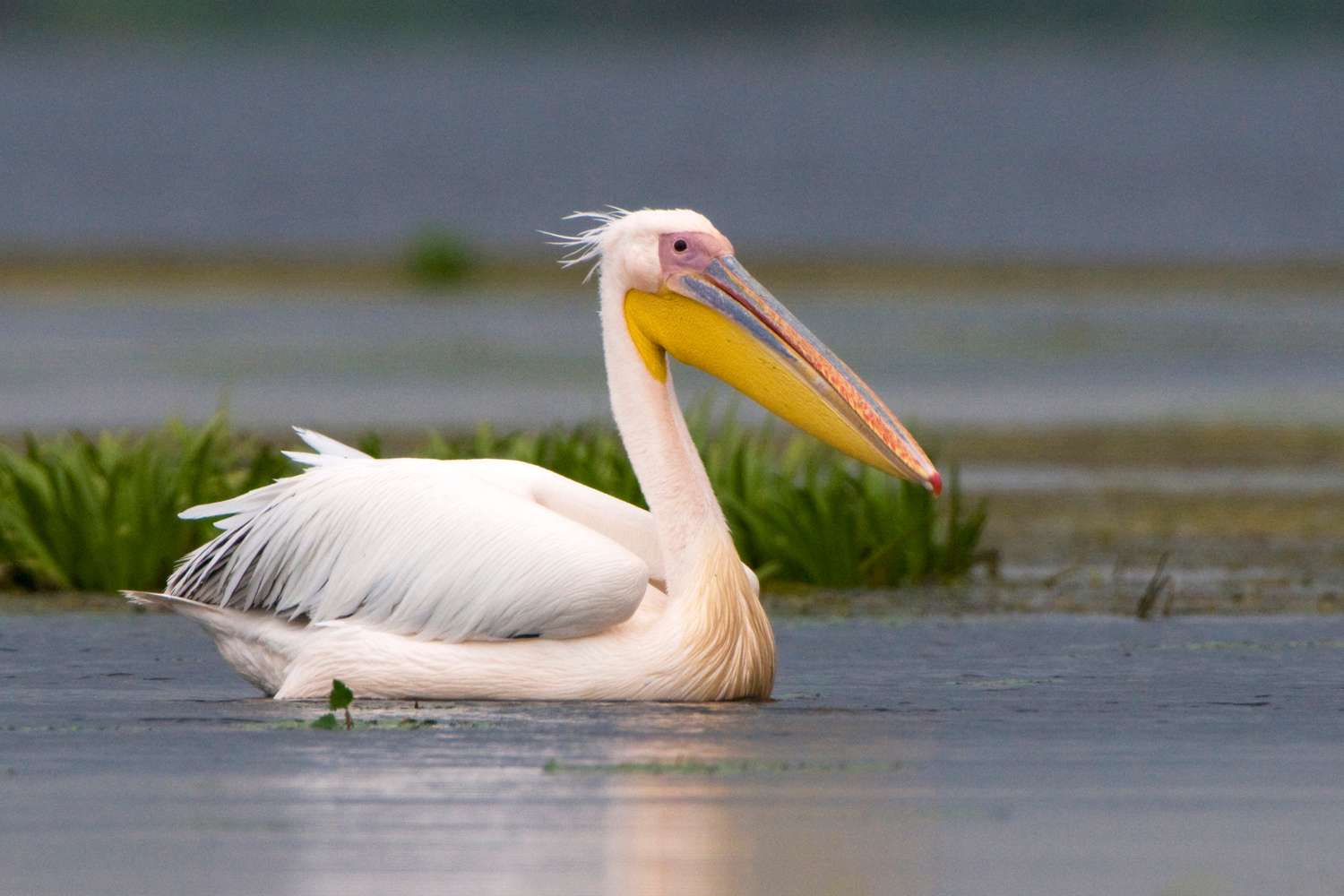Missouri, a place where both species of Pelican can be found, showcases the American White Pelican and the Brown Pelican.
Throughout the year, the American White Pelicans grace Missouri with their presence, while the Brown Pelicans are rarely seen, making them a rare sight in the state.
Pelicans, known for their colossal bills, throat pouches, and feet, stand as some of the largest and most recognizable birds in the world. Despite their immense size, they possess lightness, thanks to air pockets in their skeleton and skin, aiding in buoyancy. Furthermore, their elongated wings enable graceful soaring during flight.
Within the avian realm, there exist eight distinct species of pelicans, two of which inhabit North America—the American White Pelican and the Brown Pelican.
During the breeding season, pelicans undergo remarkable transformations. Their facial skin, throats, and bills adopt vibrant hues, while some even develop additional features on their bills.
Pelicans exhibit a communal breeding pattern, forming colonies comprising up to 50,000 birds. Depending on the species, these colonies may either nest on the ground or in trees. After approximately 25 days of nest-dwelling, the young pelicans gather in groups called “creches,” consisting of up to 100 individuals. Astonishingly, the parents possess the remarkable ability to recognize their own chicks and provide nourishment exclusively to them.
While pelicans engage in predatory behavior, they do not fall under the category of birds of prey, which encompasses solely raptors. The primary diet of pelicans revolves around fish, although they also consume crabs, frogs, snakes, mammals, birds, and insects.
The distinctive throat pouch of pelicans serves as a fishing tool, enabling them to catch fish and drain out excess water before swallowing. Moreover, young pelicans directly feed from their parents’ pouches.
To assist in the identification of pelican species observed in Missouri, this guide draws from the invaluable resources of Avibase and incorporates data collected by dedicated bird enthusiasts on eBird. Thus, offering authentic information regarding the periods when these avian creatures can be sighted.
Two Pelican Species Residing in Missouri:
American White Pelican

The American White Pelicans are a year-round presence in Missouri, with their population surging during migration periods from March to April and September to November. They are documented in approximately 3% of summer and winter checklists and appear in up to 8% of migration-related checklists submitted by passionate bird watchers in the state.
Distinguished by their expansive wingspan, the American White Pelicans soar majestically through the skies, possessing the second-largest average wingspan among North American avian species.
During the non-breeding phase, adult American White Pelicans exhibit an overall white plumage, with black flight feathers visible during flight or when their wings are outstretched. Their eyes sport a bluish-gray hue, surrounded by yellow facial skin. Additionally, they possess pale orange bills, pouches, and feet. Juveniles, on the other hand, display light gray feathers accompanied by darker brown napes.
Breeding adult American White Pelicans boast distinctive coloration compared to their non-breeding counterparts. They develop a yellow plate on their upper bills, resembling a horn. Their bodies remain entirely white, but their eyes, bills, legs, and feet become more vividly orange.
Throughout the year, American White Pelicans undergo several molting stages referred to as “eclipse.” In spring, a visible yellowish patch emerges on their breast and chest, while blackish feathers appear on their heads during summer.
Pelecanus erythrorhynchos
Length: 60 – 63 in (152 – 160 cm)
Weight: 246.4 oz (6983 g)
Wingspan: 96 – 110 in (244 – 279 cm)
American White Pelicans engage in breeding activities within remote inland lakes across North America. Subsequently, they migrate to spend their winters along the southern Pacific Coast of the United States, the Gulf of Mexico, Mexico, and Central America. During migration, these pelicans can be observed in various western and central states of the US.
To catch glimpses of American White Pelicans, one must venture to shallow freshwater lakes, wetlands, as well as the fringes of lakes and rivers. During winter, they can be found in coastal bays, inlets, and estuaries, where they forage in shallow water and seek rest on sandbars.
The primary diet of American White Pelicans consists of fish. They engage in surface swimming and seize their prey with their formidable bills. They also exhibit cooperative foraging, forming groups with other birds to efficiently drive fish towards the shore, where they can be easily scooped up.
Furthermore, American White Pelicans display opportunistic feeding behavior, traveling considerable distances in search of superior feeding grounds. They are known to consume crayfish, amphibians, salamanders, and even engage in fish theft from other avian species on the water’s surface.
In terms of vocalization, American White Pelicans are generally silent, emitting only occasional grunts. However, their young offspring can become quite noisy within large colonies, clamoring for food.
American White Pelican Nests: These avian creatures construct simple, shallow depressions on the ground as their nests. They augment these hollows with twigs, sticks, reeds, and other materials to provide protection for their eggs.
The female pelican lays one to two eggs, which are diligently incubated by both parents for up to thirty-six days. Unfortunately, due to siblicide, a phenomenon where one sibling kills the other, only one chick per nest typically survives.
Interesting Fact: The elongated and enormous bill of the American White Pelican has the capacity to hold three gallons of water. When the pelican snatches fish from the sea, it tilts its bill downwards, allowing the water to drain out, leaving the fish to be swallowed from within its throat sac.
Brown Pelican

The Brown Pelican, although a rare or accidental sight in Missouri, has occasionally been observed during the summer season. The last recorded sighting occurred in 2015 near the Swan Lake National Wildlife Refuge.
Non-breeding adult Brown Pelicans exhibit white heads and necks, adorned with pale yellow foreheads. Their lengthy bills possess a blend of yellow and orange hues. Grayish-brown bodies, short black legs, and webbed feet complete their appearance. As for juveniles, they showcase brown heads, necks, backs, and wings, along with bluish-gray bills, while their underparts feature a light brown shade.
Within the Brown Pelican species, five subspecies exist, with two breeding populations residing in the United States—P.o.californicus along the Pacific Coast and P.o.carolinensis along the Atlantic Coast.
During the breeding season, distinctions between Pacific and Atlantic Brown Pelicans become more evident. Both species possess white heads with prominently yellow foreheads. However, the napes of Atlantic Brown Pelicans transform from white to dark brown, while their counterparts on the Pacific Coast develop red skin on their throat pouches. Atlantic Brown Pelicans also sport olive-brown throat pouches.
Pelecanus occidentalis
Length: 48 – 50 in (122 – 127 cm)
Weight: 131.2 oz (3718 g)
Wingspan: 78 – 84 in (198 – 213 cm)
Brown Pelicans either breed, migrate, or maintain a year-round presence along the Pacific and Atlantic Coasts of North America, extending into northern South America.
For encounters with Brown Pelicans, one should explore environments characterized by shallow waters. These birds inhabit estuaries and coastal marine habitats throughout the year. Additionally, they can be observed on mangrove islets, as well as resting on sandbars, breakwaters, and offshore rocks.
Brown Pelicans possess a remarkable foraging ability that sets them apart. They plunge into the depths of the ocean to capture prey within their throat pouches. Upon resurfacing, the water drains from their pouches, enabling them to swiftly consume their catch.
Their primary diet consists of fish, such as sardines and herring. When not engaged in diving, Brown Pelicans leisurely swim and seize prey using their bills. They may also consume crustaceans, amphibians, eggs, and other young birds.
Regarding vocalization, adult Brown Pelicans tend to remain silent, except for sporadic grunts. However, juveniles vocalize to beg for food.
Brown Pelican Nests: Unlike their tree-nesting counterparts, Brown Pelicans predominantly construct nests on the ground. These concealed and protected nests are typically found on islands, mangroves, and cliffs. The female diligently builds the nest using reeds, leaves, pebbles, sticks, and soil. Subsequently, she lays two to four eggs, which are incubated by both parents for approximately one month.
Interesting Fact: Brown Pelicans employ a unique incubation method, utilizing their webbed feet to cover and protect the eggs. This practice, while advantageous, previously posed a threat to the species when the pesticide DDT caused the thinning of eggshells, leading to breakage under the weight of their parent’s feet. Numerous conservation efforts were necessary to restore Brown Pelican populations.
